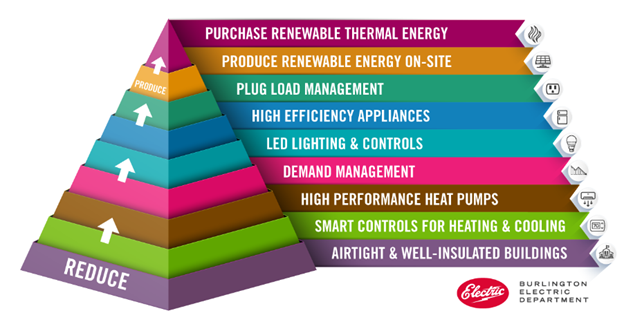Over the last few years, climate action has become a central focus for governments, and the business case for doing something about climate change has become clearer than ever before. With this shift, “Net Zero by 2050” is a term that seems to get thrown around by organizations, businesses, and municipalities alike. But what does it mean, and how do we get there? We continue our endeavor to answer this question in the second part of this two-part blog.
LE[a]D-ing the way
LED lighting is a low hanging fruit for electric savings if you have not already converted in your building. Incentives for LED lighting is expected to go away in the next couple years as LEDs become the norm, so act NOW if you have not already completed a retrofit or upgrade to LEDs. This is going to be most cost-effective in areas of your building that have high lighting use – there’s no real impetus to go through an LED upgrade in, say, a storage closet whose light gets turned on for 10 minutes a month.
LED lighting saves energy by providing the same light levels at lower input wattages. To maximize savings attributed to LEDs, consider whether lighting controls may be applicable to your space. Occupancy sensors, which turn lights down or off when occupancy is not sensed, work great in spaces like bathrooms, meeting rooms, breakrooms, warehouses, or other spaces with fluctuating occupancy. If you have a space with a lot of windows, install daylight sensors to turn lighting down when there is plenty of sunlight available. Add dimming to fixtures to allow users to adjust lighting to a level that works best for them, which also saves energy if that’s anything below 100% output. There are also options for networked lighting controls, which combine all of these lighting controls strategies plus energy monitoring, ability to schedule lighting, and more.
Unlimited Powahhhhh
Maybe you got that Star Wars reference, maybe you didn’t. In any case, unlike Emperor Palpatine, we do NOT have access to unlimited power (unless you also have unlimited funds and don’t care about the effects of energy usage on the climate), so consider reducing power draw from things like plug loads and appliances. For appliances like computers, dryers, refrigerators, stoves, etc., aim to purchase Energy Star rated options, as these have been proven to have reduced energy usage compared to other market options over the life of the equipment. Also reduce plug loads by installing advanced power strips anywhere there is currently a normal power strip installed, especially for electronics. When electronics are off or in standby mode, they still draw power. An advanced power strip actually cuts off this power draw when an electronic is turned off (or when there isn’t a device plugged into a charger). Paired with behavioral changes like turning off your computer monitor when leaving for the day and not leaving electronics plugged into their charger 24/7, advanced power strips can greatly help reduce electronics-related plug loads.
Renew Your Energy
Once you’ve done all the work you can to reduce usage in your building, focus on overcoming remaining load with renewable energy. On the electric side, this will likely include onsite solar panels, but could include wind turbines (or some technology that we don’t know of yet!). If your building is unable to electrify, either due to monetary or building construction constraints, and you are a natural gas customer, look into whether renewable natural gas is available in your area. This is natural gas developed from farm, landfill, and/or wastewater off-gassing. Learn more about Vermont Gas Systems’ renewable natural gas program.
Wrap it up already, geez!
In the end, there are a lot of steps to meet net zero energy goals, and they can seem really daunting. If you have a large portfolio of buildings, I highly suggest reading up on the Rocky Mountain Institute’s Zero Over Time guide, which helps building owners create a plan to move their building stock towards net zero. Even if you own just one or a couple buildings, connect with your utilities about incentives and programs offered to support work towards these NZE goals.
In case you missed it, check out Part I of this blog post to learn more about implementing the bottom half of the Net Zero Energy Buildings Pyramid.



